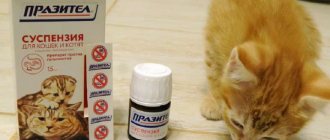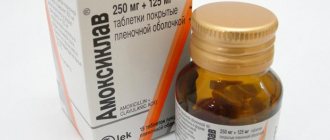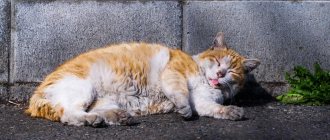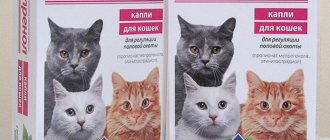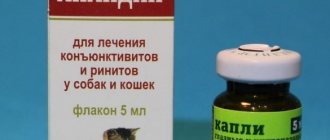Home » Useful Information
Allergic reactions are not uncommon in cats. Such pathologies provoke a number of unpleasant symptoms, including itching and skin rashes, which can be treated with antihistamines. You can use such medications only after reading the instructions and eliminating contraindications.
- 2 Types of antihistamines
2.1 Drugs of different generations - photo gallery
- 3.1 Medicines used to treat pets - photo gallery
Types of Antihistamines
The choice of antihistamines for the treatment of allergies in animals is extensive.
Manifestation of allergic dermatitis
For this purpose, antihistamines are used for cats of one of three generations. They differ in the degree and speed of impact, the presence or absence of adverse reactions.
First generation drugs
First-generation allergy medications are the least safe in terms of the possible side effects (negatively affecting the functioning of the cat’s central nervous system), but the most effective in situations where it is necessary to immediately eliminate allergy symptoms (tearfulness, sneezing, coughing).
The group of drugs under consideration includes:
- suprastin;
- diphenhydramine;
- diazolin;
- tavegil;
- pipolfen.
For your information! The duration of exposure to the body is average. One dose of the medicine is enough for 4-6 hours. To achieve a long-term effect, the dose is increased to the maximum possible (this is done exclusively under supervision and on the recommendation of a specialist).
Antihistamines
Second generation drugs
Second generation drugs do not have a negative effect on the nervous system, but their use negatively affects the functioning of the heart. Most often, fenistil, loratadine or kestin are used to treat allergies in kittens and adult cats.
Important! The choice of medication does not depend on the breed. Sphynxes, Persian, Siberian and ordinary yard cats are treated the same way.
Third generation drugs
Modern drugs that have virtually no negative effects on the body. Due to this, as well as the ability to have a positive effect over a long period of time, third-generation drugs are prescribed in minimal doses. If necessary, treatment is repeated. The most effective drugs are:
- cetirizine for cats;
- fexofenadine.
They are safe for both the central nervous system and the cardiovascular system.
Note! The antihistamine is chosen by the veterinarian after examining the cat, studying the results of blood, urine and feces tests, and information about the cause of the allergic reaction. This is the main condition for ensuring a speedy recovery of the animal.
When does a cat need medication?
How can you tell if your pet needs to be treated with cat antihistamines? Only a veterinarian can solve this issue. With minor manifestations of the disease, sometimes it is enough to remove the allergen from the house or change the type of food. However, if the animal has a severe rash, itching, runny nose, breathing or digestive disorders, then you should consult a specialist. In severe cases, the cat may develop anaphylaxis, and then the pet will need emergency help.
The owner of a pet cannot always independently determine an allergy in a cat. Manifestations of a negative reaction to various substances can be similar to signs of infection. To accurately identify the disease, laboratory tests are sometimes required. In severe cases, treatment with cat allergy antihistamines may not be sufficient and steroid hormone therapy is required.
Types of treatment
Treatment of allergies in cats can be local, complex or symptomatic. Most often, several types of treatment procedures are combined with each other.
Local therapy
Painkillers for cats: which ones can you give?
Topical products include hydrocortisone-based shampoos. If the animal is weakened and unable to lick itself, the doctor may recommend an ointment of a similar composition. At this point, local therapeutic treatment is considered complete. If the expected positive effect does not occur, tablets, drugs for intramuscular and subcutaneous administration are used as part of symptomatic and complex therapy.
Relieving itching
To relieve itching use:
- the already mentioned ointment with hydrocortisone;
- vitamin B7 (introduced into the cat’s body along with omega fatty acids, reduces itching, seborrhea, moisturizes the skin);
- steroids;
- antihistamines.
Important! Treatment for allergies caused by food irritants and allergies caused by blood-sucking insect bites differs in terms of the sequence of actions. If in the first case it is enough to eliminate the irritant and use an antihistamine, then in the second you will have to first get rid of insects and carry out deworming and only after that give the cat anti-allergy medications.
Causes of allergies in cats
A negative response of the body can occur both with a single contact with an antigen and with constant interaction with it.
Without research, it is impossible to definitively name the reason why a cat may develop an allergy.
However, veterinarians have identified some of the main causes that cause allergies in cats:
- some components of the food that the cat eats;
- tick or flea bites;
- house dust, pollen and mold;
- certain types of medications;
- litter used in the toilet;
- fur from animals living at home;
- cigarette smoke and tobacco;
- household chemicals.
It is necessary to pay close attention to your pet's condition, as allergies can cause great discomfort to the animal.
This is not the entire list of things that can cause allergies in a pet. However, these are the main antigens that are tested first if the animal is susceptible to allergies.
How to give your cat a pill correctly
Ringworm in cats: drugs for treatment
Before giving the cat a pill, he is limited in food for several hours. A hungry animal will not notice the pill hidden in a small piece of boiled meat or cutlet, and thus it will be possible to give it the medicine without any problems. If your pet refuses to eat, then:
- for 5-10 minutes. calm the cat: pet it, play with it;
- they take him in their arms, put him on their knees and squeeze him between them;
- gently unclench their jaws;
- put a pill in the open mouth;
- squeeze the cat's jaws, preventing the cat from getting rid of the drug.
The cat quickly orients itself and swallows the medicine, so you won’t have to keep its jaws closed for long, 1-2 minutes is enough. After the procedure, the animal’s mouth and fur are examined to make sure that the tablet did not fall out or get lost somewhere.
Antihistamines for cats: a brief overview
Allergic reactions are not uncommon in cats. Such pathologies provoke a number of unpleasant symptoms, including itching and skin rashes, which can be treated with antihistamines. You can use such medications only after reading the instructions and eliminating contraindications. Antihistamines are used to eliminate allergic reactions in cats.
Medicines are prescribed after a series of studies and confirmation of the diagnosis. Medicines in this group help eliminate itching, burning, skin rashes and lacrimation.
The effect of such drugs is due to the binding of histamine and a decrease in its production. It is this substance that provokes the appearance of characteristic allergy symptoms. The drugs affect both the secretion of histamine and the elimination of the consequences of its active production. Antihistamines relieve cats from itching associated with an allergic reaction to something.
In some cases, such medications can relieve the cat of edema, which can contribute to the occurrence of anaphylactic reactions that are life-threatening for the pet. In addition, antihistamines reduce the manifestations of the inflammatory process and have a slight calming effect. Antihistamines only eliminate the symptoms of allergies, but do not get rid of the cause itself.
You cannot choose antihistamines for treating pets on your own, since not all drugs are suitable for cats.
Many veterinarians advise using first-generation antihistamines if your pet has a severe allergic reaction. Such medications best eliminate anaphylactic shock, bronchospasm and other dangerous symptoms. For dermatitis, it is best to give preference to second and third generation medications.
Antihistamines that are used to treat people can also be given to cats, but only after first consulting a doctor. Only a veterinarian can establish an adequate dose and course of therapy depending on the symptoms. When the cat had an allergic reaction, she was given a first generation antihistamine. The pet had dermatitis of unknown origin. The whole stomach was bald, there were rashes and severe itching.
After taking the medication, the symptoms disappeared, the cat stopped licking itself and scratching the sores. Unfortunately, after stopping the medication, the allergy symptoms returned. Antihistamines are an effective remedy that can eliminate a wide variety of allergy manifestations. At the same time, the pet becomes calmer and is no longer tormented by unpleasant symptoms.
Giving an animal antihistamines is allowed only after consultation with a doctor. Leave a review Cancel review. Contents 1 When antihistamines are needed and how they work. Suprastin is a drug of the first generation of antihistamines. Xyzal is a representative of the third generation of antihistamines. Zodak is a second generation antiallergic drug. From 40 rub. Chloropyramine solution; pills. From 79 rub.
Zirtec Oral drops cetirizine dihydrochloride Second allergic dermatoses; hives; allergic runny nose. From RUR Claritin tablets; syrup. Suprastinex tablets; drops. Lordestin tablets; syrup. Individual intolerance. Claritin belongs to the second generation of antihistamines Lordestin effectively eliminates allergy symptoms Diphenhydramine eliminates anaphylactic reactions Suprastinex belongs to the third generation of antihistamines Zirtec effectively eliminates itching Chloropyramine has a pronounced sedative and antiallergic effect.
Author: Ksenia Kalugina Print Rate the article:. What painkillers are used to treat cats. What effective laxatives are used to treat cats.
Sedative for cats: what drugs can be used and when. We will be glad if you leave your opinion:. Leave a review Cancel review Join:.
Facebook Google VKontakte. Search form.
The most effective drugs
To treat allergies in cats, they use proven remedies, often suitable not only for animals, but also for humans, and therefore are sold in a regular non-veterinary pharmacy. But, before purchasing the drug yourself and giving it to your animal, you need to call the veterinary clinic and ask, for example, whether cats can be given loratadine for allergies or any other drug recommended by the pharmacist (the list of drugs is quite long).
Mexidol injections
Deworming tablets for cats: anthelmintic drugs
Available in two forms - injections and tablets. Injections are the most effective and safe. The drug is prescribed to improve blood circulation, increase the body's endurance (acts as a sedative), and against skin diseases. Injections are used for acute forms of the disease. The estimated dose is 15 mg per 1 kg of weight. Adverse reactions occur only if the animal has an individual intolerance to this antiallergic drug for cats.
For your information! Mexidol should be used with caution if kidney or liver function is impaired.
Omega-3
Omega-3 fatty acids are a supplement that can be beneficial for animals. This is not a medicine, but an additional source of active substances. The drug helps maintain the animal’s coat in proper condition (this is especially true when breeding Scottish cats), prevent the development of dermatitis, and reduce the intensity of aggravated skin diseases.
Important! Give omega-3 regularly, and not just when an allergic reaction occurs.
Cyproheptadine (peritol)
Available in the form of tablets and syrup. The drug is used to prevent allergies or alleviate their symptoms. Peritol relieves itching, acts as an anticholinergic, antiexudative and sedative. The dosage is selected by the doctor. Zyrtec for cats has a similar effect on the body, the dosage of which is also selected solely on the recommendation of a specialist.
Zyrtec
Clemastine (tavegil)
Relieves runny nose and cough. After taking the drug, the animal stops sneezing and tears stop rolling from the eyes. The positive effect lasts for a long time. To achieve it, it is enough to give the cat 0.5 tablets every 12-24 hours. The drug affects the central nervous system, which is why the animal becomes apathetic, refuses to eat, and often goes to the toilet (loose stools).
Zodak and Zodak Express
Zodak is a 2nd generation antihistamine. It is produced in the form of tablets, drops, syrup and solution for injection. The product begins to act after 15 minutes. after introducing it into the cat’s body, it helps with various types of allergies, is effective for 24 hours, and does not contain sugar. Zodak is suitable for cats of all ages; there is a drug for kittens. The dose depends on weight. The drug blocks the release of histamine, and there are practically no side effects after its use.
Suprastin
Suprastin is an antihistamine used to treat allergies in humans and animals. The dose depends on weight, 0.25 tablets are given for every 5 kg of weight (it cannot be exceeded, sharply negative reactions are possible). The course of treatment depends on the doctor’s recommendation, but usually does not exceed three days.
Note! Suprastin can also be purchased in the form of injections.
Suprastin
Hydroxyzine
The antihistamine calms, suppresses vomiting, relieves pain, and helps the pet breathe as it promotes dilation of the bronchial tubes. To treat an adult cat, it is enough to give her up to 15-20 mg of allergy medication for cats per day.
Diphenhydramine
Often used to get rid of allergies resulting from insect bites. After using the drug, the animal becomes lethargic and sleeps a lot (this is normal). The side effects are the same as with regular diphenhydramine. Diphenhydramine should not be given to kittens, pregnant animals, or lactating cats, or together with medications to lower body temperature. To relieve signs of allergy, it is enough to give an adult animal 2-6 mg of the substance once a day.
Chlorpheniramine
Helps with feline dermatitis and urticaria, but long-term use is prohibited (up to three days in a row). The drug is taken when acute signs of the disease appear. It is administered intramuscularly or orally (before or after meals). Dose - 1-2 ml for intramuscular administration and 2-4 ml for oral administration.
Main symptoms of allergies in cats
The main causes of allergies in cats are insect excrement, house dust, mold fungi, plant pollen, human hair, dander, household products or the hair of other animals that live in the same area as the pet.
In addition, certain medications, litter, or tobacco smoke can cause allergies. Therefore, the main problem in diagnosing allergies in cats is identifying the suspected allergen.
Depending on the type of allergy your cat has, different signs may appear. As a rule, these are skin lesions that are especially pronounced in the head, back, neck, and behind the ears.
The main signs that indicate that a cat has an allergy:
- runny nose, sneezing;
- wheezing, suffocation;
- salivation;
- redness of the mucous membrane of the eyes, as well as lacrimation;
- hair loss in an animal;
- the appearance of dandruff;
- dry skin;
- itching and redness of the skin.
The animal may also become more restless, begin to chew out its fur, and its general health may worsen. Sores may appear on the body, which the cat constantly tries to lick.
What to do in case of overdose
In case of an overdose of antihistamines, the affected cat is immediately taken to a veterinary clinic. If this is not possible, then it is necessary to rinse the animal’s stomach by drinking plenty of water and inducing vomiting, and also do not feed it for the next 10-12 hours.
An allergy is a reaction of an animal’s body to irritants, which, unfortunately, does not disappear even after their elimination and causes discomfort to the animal. Antihistamines of different generations are used to treat allergies. The choice of a specific remedy should be left to the veterinarian, therefore, without knowing what to give to cats for allergies, it is better not to experiment. Self-treatment is allowed only in the form of using antihistamine shampoos. If the allergy does not go away, contact a specialist and treat the cat in accordance with his recommendations.
What is an allergy and its types
Before you start giving Cetrin to cats, you should understand what allergies are, how they are expressed, and what types of allergies can occur in your pet. The disease is the reactivity of the animal's body or perverted sensitivity to a certain substance. The severity of the disease varies from cat to cat.
Various substances can act as allergens. The disease can be divided into several main types.
- Food allergies. Sensitivity to various feeds and components may occur. Quite rare in cats.
- To the saliva of most insects. This may be flea dermatitis, hypersensitivity to the bites of flies, mosquitoes and small midges.
- Atopy. In this case, reactions manifest themselves to many components of the environment. These may include mold, dust mites, and pollen from all kinds of plants.
Sometimes even a seemingly insignificant allergen is enough to trigger a reaction and the disease to begin to progress. It is impossible to place your beloved cat in a completely sterile environment. Therefore, you often have to take Cetrin and other drugs required to suppress allergic reactions for life.
Cetrin is available in the form of syrup or tablets. The manufacturer is an Indian pharmaceutical company. Cetrin syrup is a special uncolored transparent solution. You can buy it in dark glass bottles. The volume is 60 or 30 ml. The solution has a not pronounced, but quite pleasant fruity smell.
Treating a cat using Cetrin is much safer. It does not cause side effects such as drowsiness, lethargy, or central nervous system depression. However, the antiallergic effect of Cetrin is much less pronounced. Loratadine has an even milder effect. It rarely helps against food allergies; it takes too long to work against insect bites.
Loratadine for cats – dosage, instructions for use – Website about pets
Cats, like many mammals, can suffer from allergies and require medications to relieve symptoms. Antihistamines for cats and people may be the same.
So, Claritin and Tavegil are recommended for animals. When choosing a medicine, it is important to clearly understand what symptoms it should overcome.
It is advisable for the owner to know about the type of drug (which generation it belongs to) and its potential side effects.
Types of Antihistamines
The drugs got their name due to their main function - inhibiting the action of histamine.
The substance is released when the membrane of mast cells (mast cells) is destroyed when an allergen enters the body.
Medicines prevent histamine from harming the body by preventing it from connecting to receptors (in particular, H1). The effectiveness of preventing this connection depends on the novelty of the antihistamine:
- 1. First generation. Least effective means. Low level of receptor compliance requires large doses and provides a short-lived effect. The medications are taken at least 2-3 times a day. The drugs have serious side effects, such as drowsiness and possible heart palpitations. From the extensive list of these drugs, cats are prescribed Donormil, Diphenhydramine, Tavegil, Diazolin, Dimenhydrinate, Bicarfen, Pipolfen or Teralen.
- 2. Second generation. A more precise “fit” eliminates unwanted effects on the nervous system and off-target receptors, but the risk of negative effects on the cardiovascular system remains. Can be taken once a day. From this category you can give your cat Tenset, Astemizole, Terfenadine, Soventol, Fenistil or Kestin.
- 3. Third generation. The most selective drugs that do not affect the nervous system. Animals are prescribed Fexofenadine and Cetirizine for allergies.
Each category includes other medications, but these may not be suitable for your cat. Thus, when people have an allergic reaction, they are prescribed H2 receptor blockers, which will not help animals. The owner can choose a product of any generation, but always consult a veterinarian.
When to use
Allergies in cats are manifested by itching, redness of the skin with hair loss in the affected areas, blisters, nasal discharge, otitis media, diarrhea and vomiting.
All symptoms are nonspecific and may be a sign of another disease. Wool falls out when there is insufficient intake of fatty acids in the body or disruption of the functioning of internal organs.
Blisters may result from contact with the chemical.
The diagnosis must be made by a veterinarian. He also prescribes an antihistamine and additional medications, such as steroids, to combat inflammation. If it is impossible to see a doctor, the owner can try to help the pet on his own. But he must be sure that his pet is suffering from allergies.
The seasonality of outbreaks will indicate allergies. Just like people, cats suffer from pollen allergies. Having noticed signs of atopic dermatitis during the flowering period, the owner can carry out a course of treatment without a visit to the clinic. Since such allergies are lifelong, the procedure becomes familiar to the owner.
How to give medicine
The dosage and route of administration depend on the type of drug. Most antihistamines are given to cats in the form of tablets. When using Diphenhydramine, the dosage is 1–4 mg per kilogram of animal weight. The drug is given once every 8–12 hours.
It should not be mixed with food or drink (except water). Tavegil and Clemastine are given to adults, regardless of size, half a tablet once every 12 hours. Some medications can be mixed with your pet's favorite food for convenience.
But mostly doctors recommend using tablets without mixing them with food.
Allergic reactions to food, cosmetics, flowers of various plants, and medications occur not only in humans. also common in cats.
, it causes deterioration in physical condition. Cats suffer because of this, and it is up to humans to help the animal cope with the problem.
Allergy is a common disease
, it occurs in every fifth cat. And responsible owners always turn to the veterinarian with the question of what can be given to their cat for allergies. Before prescribing treatment, the doctor determines the cause of the ailment and the factors that cause the reaction.
Experts identify several types of allergies
, the main one is
food
. Cats may have a reaction to a certain brand of food or to natural products (fermented milk, vegetables or even fish).
There are also allergic reactions to artificial materials
(plastic, rubber) from which toys for animals are made.
An attentive owner can find out the cause of the disease in kittens or an adult animal; in more complex cases, special tests in a veterinary clinic can help. Depending on the causative agent of the allergy, the doctor decides how to treat the cat and how to restore health.
.
Symptoms in cats
The symptoms and treatment of an allergic reaction are interrelated.
Each form of allergy can manifest itself with certain symptoms, diseases of certain body systems.
INTERESTING!
Light-haired cats are more likely to react negatively to certain foods than their dark-haired counterparts. Therefore, owners of such pets should choose food very carefully.
There are many symptoms, and it is sometimes difficult to distinguish an allergy from another disease. The main ones are rash, itching
(the animal scratches the skin vigorously until wounds appear),
redness of the skin
(this is especially visible in the ears).
ATTENTION!
Sphynx cats are the most susceptible to allergic reactions. But signs of the disease are immediately visible on their skin, so the owner can begin treating the pet at an early stage.
In fluffy cats, rashes and dermatitis are complemented by severe hair loss
. A clear sign that is not typical for a healthy animal is dandruff.
British cats or other breeds with long hair need to be examined more closely
, since scratching wounds may be in hidden places (under the chin, on the tummy).
Symptoms of diseases
An accurate diagnosis would help quickly determine the cause of the allergic reaction. But complex allergy tests are not performed on cats; the procedure is too expensive.
Moreover, many allergens can only be introduced to an animal under anesthesia.
- In the absence of special tests, the source is determined by excluding provoking factors.
- In this diagnosis, an important role is given to the person who will observe the pet’s reaction to food and filler.
- After such a diagnosis, it will be easier for the veterinarian to decide how to cure an allergy to a particular substance.
ATTENTION!
A reaction to a product, flea bites or litter material sometimes does not appear immediately.
For a long time, harmful endogenous substances accumulate in the body, and only the appearance of a strong allergen causes a surge in the disease. Especially often, signs of food allergies do not show themselves for a long time. But attentive owners will be able to notice in time that the cat looks unhealthy, constantly scratches its skin, and shows irritation.
.
Treatment of allergies in cats
- It is necessary to immediately relieve itching, inflammation on the pet’s skin, and treat scratched wounds
. - It is important to calm the cat
, because skin diseases lead to severe irritation. - Each remedy is selected individually
, since the animal may have a negative reaction to medications.
- Antihistamines
for cats are necessary for all types of allergies; they soothe, reduce skin manifestations, swelling, and irritation. - To restore good skin condition, a special healing and soothing ointment
. If there are wounds, the product should also have a disinfectant effect.To prevent your cat from licking medications from the skin, you need to put a special collar on her during treatment.
- If you have a food allergy, it is important to follow a diet that includes neutral and fresh products
. The diet is needed for a long time, and the provoking product is excluded in the future, so as not to cause food allergies again.You can identify a negative reaction to a product if you replace chicken with fish or store-bought fermented milk products with cottage cheese or home-made yogurt. Most often, proteins of animal or plant origin become allergens in a cat’s body.
- a large number of dry food of different brands
on sale , and it is this type of food that is leading in the field of food allergies. You need to carefully monitor your pet’s reaction to a new food; when the first signs of illness appear, you should change the brand of food and try a different composition. - Antihistamine and corticosteroid tablets are prescribed for atopic dermatitis. A medicine that completely cures this disease has not yet been created, so it is important to regularly monitor the manifestations of the disease. Atopy is especially difficult to manifest in spring and autumn; you need to help your cat survive such seasons.
Dermatitis may also be accompanied by a bacterial or fungal infection.
- With atopy, the skin first becomes dry, severe itching appears, debilitating the pet
. In places where scratching occurs, the wounds even turn into wet ulcers, complicated by infections.Any factor can provoke an allergy - a new product, some kind of grass, a powder that was used to wash the bedding. The disease cannot be cured, but the cat’s symptoms should be alleviated, itching should be relieved with medications, and ointment should be applied to the wounds.
ATTENTION!
Peeling of your cat's paw pads may indicate an allergic reaction to the litter in the litter box.
For all breeds, veterinarians recommend choosing a litter without odor or small particles
.
It is advisable to read on the packaging what kind of wood this product is made from, because a reaction to a certain type of wood is possible. Peeling of the pads may also indicate an allergy to household chemicals or washing powder
.
Skin irritation in a kitten or adult animal caused by insects is also a health problem. You can protect your pet from fleas with a special collar and anti-flea shampoo.
. Swelling and even difficulty breathing in a cat after a wasp or bee sting are possible. In this case, you need to quickly give your pet antihistamines and sedatives.
At home, with proper treatment and following the doctor's recommendations, it is not difficult to cure allergies. Manufacturers produce tablets, ointments, drops. You can choose the form of medication that is more convenient for treatment.



